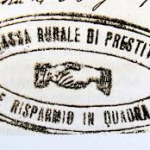Cassa Rurale
It’s a cooperative society with limited or unlimited responsibility for the exercise of popular credit, in favour of farmers and craftsmen.
The first cassa rurale was founded in 1849 in Prussia through the work of F.W.Raiffeisen and starting from 1880 the institution spread to other European countries.
In 1892 don Lorenzo Guetti established in Quadra of Bleggio the first Raiffeisen type of cassa rurale of Trentino, which was the southernmost part of the Austro-Hungarian Empire at that time.
In 1894 the entrepreneur priest of Giudicarie Esteriori wrote in the agrarian yearbook: “in every well-administered little village there should be, in addition to a church and a school, also a cassa rurale and a cooperative society/Famiglia cooperativa. A Cassa Rurale is needed first of all to plant even in tender youth the will to save money, without falling for the usurer and without carrying out any illegal action”.
Leone Wollenberg founded the first of such an institute in the Kingdom of Italy in Loreggio (Padua) in 1883 and his example was widely followed, both for the features of “familiar economy” which are specific of the customers of the cassa rurale, and for the particular conditions of Italian agriculture, that needed cash funds, and for the clergy’s interest.
The number of rural banks reached its peak in Italy in 1922 (3540), with a particular concentration in Trentino and in South Tyrol.
In the essay The S&L association of Loreggia, included in the volume, Leone Wollemborg writes: “the savings and loan association of Loreggia, a cooperative Society with unlimited responsibility, is the first of such kind in our country (Kingdom of Italy) and it reproduces in our statute, with few modifications, requested because of the difference of of conditions, customs and laws, the kind and principles of the beneficial Association of rural credit first in the Rhine province thanks to the meritorious F.G. Raiffeisen. The first S&L of Loreggia (little rural municipality in the province of Padua with 2935 inhabitants, almost exclusively farmers) was notarially established on 20th June 1883 (...) The Society knows no shares or dividends; it doesn’t extend beyond the municipality of Loreggia; all offices are free of charge; no transaction is done except receiving deposits from members and people outside the company and lending out loans to members (…) The members who were present at the deed of partnership were 32 (..) The organisation of Society and the way it works are extremely simple so that farming people can understand it”.

Per approfondire:
• Andrea Leonardi, Dalla beneficenza al mutualismo solidale: l’esperienza cooperativa di F. W. Raiffeisen e i suoi primi riflessi in Italia, 2000;
• Pietro Cafaro, La solidarietà efficiente. Storia e prospettive del credito cooperativo in Italia (1883-2000), Laterza, Roma, 2001
• Andrea Leonardi, Una stagione nera per il credito cooperativo. Casse rurali e Raiffeisenkassen tra il 1919 e il 1945, Il Mulino, Bologna, 2005





